
Importance of Refrigerator Maintenance
Benefits of Regular Maintenance
Regular maintenance for refrigerators is crucial in ensuring they operate at their best level and have an extended lifespan. By implementing simple routine tasks, you can prevent unexpected breakdowns, costly repairs, and the inconvenience of a malfunctioning appliance. Whether you decide to perform the maintenance yourself or enlist the help of professionals, prioritizing refrigerator maintenance is essential for keeping your appliance in optimal condition for many years to come.
Preventing Breakdowns
One of the primary reasons why regular refrigerator maintenance is important is that it helps you avoid unexpected breakdowns. By adhering to a maintenance schedule, you can identify and address potential issues before they escalate into significant problems. This proactive approach not only saves you money on costly repairs but also reduces the stress and hassle of dealing with a malfunctioning fridge. Consistent maintenance will not only help your refrigerator last longer but also ensure that it operates efficiently, saving you time and energy in the long run.

Cleaning the Inside of the Refrigerator
Removing expired food items
To start deep cleaning the inside of your refrigerator, it’s essential to remove any expired or spoiled food items. Begin by turning off the power to your refrigerator via the electrical panel or by unplugging the appliance. Take out all food from both the refrigerator and freezer compartments, and place them in coolers to ensure they stay at a safe temperature. This is also a good opportunity to check for any hidden spills or leaks that may have occurred.
Wiping down shelves and drawers
Once all the food has been removed, it’s time to thoroughly clean the shelves and drawers of your refrigerator. Using a mixture of warm water and dish soap, wipe down the walls, ceiling, and bottom of the refrigerator with a clean sponge or cloth. Be sure to get into all the corners and crevices to remove any dirt or spills. For tougher stains or spills, you can use a solution of vinegar or baking soda. Remove the drawers and shelves and clean them in the sink with hot, soapy water before thoroughly drying them. This process will help keep your refrigerator clean, fresh, and functioning efficiently. Remember to rinse all surfaces with a soft, damp cloth to ensure no soap residue is left behind.

H2
Cleaning the Outside of the Refrigerator
H3
Cleaning the exterior surfaces
When cleaning the exterior of your refrigerator, it is crucial to use the proper methods to maintain its pristine condition. To start, mix warm water with a mild soap or detergent to wipe down the steel exterior and gaskets. Using a clean microfiber cloth or a soft cloth is recommended to avoid scratches or damage to the appliance’s surface. Avoid using paper towels as they can potentially scratch or dull the clear coat of the painted door. Regularly using a household appliance cleaner and polish can help protect the finish and keep your refrigerator looking brand new. Remember to refer to your Owner’s Manual for specific cleaning instructions tailored to your refrigerator model.
H3
Vacuuming the coils
Another essential aspect of maintaining your refrigerator is to regularly vacuum the coils at the back or bottom of the appliance. Over time, dust and debris can accumulate on the coils, affecting the refrigerator’s cooling efficiency. Unplug the refrigerator before vacuuming to ensure safety. Using the brush attachment of a vacuum cleaner, gently remove any dirt or debris from the coils. This simple maintenance task can prolong the life of your refrigerator and keep it running smoothly. Be sure to plug the refrigerator back in once you have finished cleaning the coils to resume normal operation.

H2 Title:
Checking and Maintaining Seals on the Doors
H3 Titles:
Inspecting for cracks or gaps
Cleaning and replacing seals if necessary
When it comes to maintaining your commercial refrigerator, checking and maintaining the seals on the doors is crucial in ensuring its efficiency and preventing warm air infiltration.
Inspecting for cracks or gaps:
Begin by visually examining the door gaskets for any signs of damage such as cracks, tears, or brittleness. Close the fridge door and check for any gaps or air leaks along the seals. It is essential to address any issues promptly to avoid warm air entering the unit and compromising its cooling capabilities.
Cleaning and replacing seals if necessary:
If you notice any gaps or damaged seals during the inspection, take the necessary steps to rectify the situation. Apply appropriate sealing materials to close any gaps you find, or replace damaged door seals to ensure a proper seal. This maintenance task is crucial for keeping your commercial refrigerator functioning optimally and preventing energy waste.
Regularly inspecting and maintaining the seals on the doors of your commercial refrigerator is a simple yet effective way to maximize its efficiency and longevity. By addressing any issues promptly, you can avoid costly repairs and ensure that your unit operates at peak performance. Remember, preventive maintenance is key to keeping your refrigerator in top shape and avoiding any potential breakdowns.
H2 Title:
Monitoring Temperature Settings
H3 Titles:
Ensuring optimal temperature
Adjusting settings as needed
When it comes to maintaining a commercial refrigerator, monitoring the temperature settings is vital for preserving food quality and safety. Ensuring that your refrigerator is set to the optimal temperature range will help prevent food spoilage and keep your products fresh for longer periods.
Ensuring optimal temperature: Place a reliable thermometer inside your refrigerator in an area that represents the overall temperature. Let it sit for a few hours to get an accurate reading of the internal conditions. A refrigerator that is too warm can lead to bacterial growth and food spoilage, while a temperature that is too cold can freeze certain foods. Regularly monitor the thermometer and adjust the controls accordingly to maintain the ideal temperature for your specific storage needs.
Adjusting settings as needed: Periodically check the temperature readings and adjust the settings as necessary. If the temperature is not within the recommended range, make the required changes to ensure that your refrigerator maintains a consistent and safe environment for your food items. By staying vigilant and proactive in monitoring and adjusting the temperature settings, you can prevent costly breakdowns, food loss, and maintain the quality of your stored products.
In conclusion, taking the time to monitor and adjust the temperature settings of your commercial refrigerator is a proactive measure that can save you from unexpected expenses and preserve your food inventory. Prioritizing regular temperature checks and control adjustments is a simple yet effective way to ensure that your refrigerator operates efficiently and keeps your food fresh and safe. Remember, preventive maintenance is key to avoiding breakdowns and costly repairs in the long run.

H2 Title:
Defrosting the Freezer
H3 Titles:
Manual defrosting process
Preventing ice buildup
Blog Section:
Defrosting the Freezer
Manual defrosting process
When it comes to maintaining a manual defrost refrigerator, it’s essential to follow the correct procedures for defrosting the freezer compartment. The process should be initiated when the frost buildup reaches around 1/4 to 1/2 inch thick. Frequent defrosting may be required if the freezer sees regular use or is exposed to high humidity levels. It is crucial never to operate a manual defrost refrigerator for more than six months without fully defrosting the freezer to maintain optimal performance.
To manually defrost the freezer compartment, start by removing all contents stored inside. Once the freezer is empty, unplug the refrigerator to ensure safety during the process. Allow the frost to melt naturally or speed up the process by using hot sudsy water and a cleaning cloth to melt away the ice crystals. This process will ensure the freezer is free from excessive ice buildup, which can affect the efficiency of the appliance.
Preventing ice buildup
To prevent the need for frequent defrosting and maintain the freezer’s efficiency, there are steps you can take. Regularly monitor the frost accumulation and defrost the freezer compartment as needed. Additionally, keeping the refrigerator door closed when not in use can help minimize ice buildup. By implementing these preventive measures, you can prolong the intervals between manual defrosting sessions and ensure the optimal performance of your manual defrost refrigerator. Remember that proper maintenance of your appliance will not only extend its lifespan but also help in keeping your food fresh and safe. [21][22][23][24]

Troubleshooting Common Issues
Addressing unusual noises
When dealing with a refrigerator that is not cooling properly, it is essential to pay attention to any unusual noises coming from the appliance. Strange sounds like rattling, buzzing, or grinding could indicate underlying issues such as a malfunctioning compressor or fan motor. If you notice any of these noises, it is advisable to shut off the refrigerator and seek professional assistance to prevent further damage.
Solving cooling problems
One of the most common issues with refrigerators is improper cooling. If your refrigerator is not maintaining the right temperature, there are several steps you can take to troubleshoot the problem. Start by checking the temperature settings to ensure they are correctly configured. Additionally, inspect the door seals for any signs of wear or damage that may be causing air leaks. Clean the condenser coils regularly to ensure efficient heat transfer, and check the evaporator fan for any obstructions that may be hindering airflow.
By addressing unusual noises promptly and taking proactive measures to solve cooling problems, you can ensure that your refrigerator operates efficiently and keeps your food fresh. Regular maintenance and troubleshooting can help prevent costly repairs and prolong the lifespan of your appliance. Remember, when in doubt, always consult a professional technician to accurately diagnose and fix any complex issues with your refrigerator. Following these troubleshooting steps can help you identify the root cause of the problem and potentially resolve it before it escalates into a more significant issue.

H2 Title:
Schedule for Routine Refrigerator Maintenance
Weekly tasks
When it comes to maintaining your refrigerator, there are tasks that you and your staff can incorporate into your daily or weekly routine. Cleaning the equipment should be a top priority to prevent the buildup of dirt and grime. Checking the settings regularly ensures that the temperature is appropriately configured, helping your fridge operate efficiently. It is crucial to defrost the refrigerator on schedule and clean out any units to avoid overcrowding, which can hinder proper airflow.
Monthly tasks
Performing a deep clean on a monthly basis helps remove any accumulated residue and ensures hygienic storage of food items. Discarding old or spoiled food prevents contamination and unwanted odors. Checking that vents are clear and open allows for proper air circulation within the refrigerator. Testing the door seal ensures that it is tight, preventing cold air from escaping. Changing water filters regularly maintains water quality. Cleaning the coils helps improve cooling efficiency, while clearing out the drip pan and drain hole prevents blockages. Lastly, ensuring that the fridge is level helps optimize performance.
By adhering to these routine maintenance tasks, you can prolong the lifespan of your refrigerator, prevent potential breakdowns, and keep your food fresh. Consistent upkeep of your refrigerator not only saves you money on repairs but also ensures that the appliance operates at its best. If you notice any issues beyond your expertise, it’s advisable to seek professional help to address the problem promptly. Regular maintenance is key to keeping your refrigerator in top working condition.